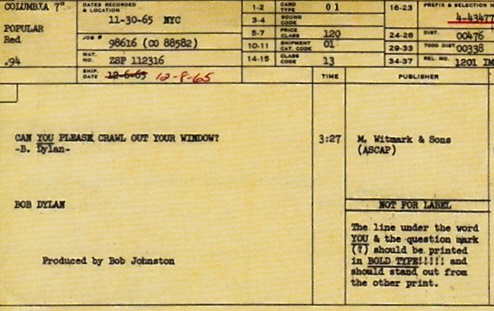
How do we know exactly when records came out, at a distance of over half a century? There has been much disagreement about the real-world release dates of some of Dylan's records of this period, not helped by occasionally inconsistent or incorrect information from his record company. By 'real-world' I mean the date that a record was actually available in stores in the United States; other countries usually lagged behind to some degree.
As a starter, the box-set booklet for The Original Mono Recordings (2010) provided a list of release dates for Dylan's Columbia singles and albums from 1962 to 1967. Then in 2015 the books that accompanied The Bootleg Series Vol.12: The Cutting Edge 1965-1966 (in its various editions) featured reproductions of numerous studio documents which shed further light on the matter. The documents included quite a number of what I call 'release cards' (I don't know what Columbia really called them); these were apparently typed up in advance of the release of an album or single, and provided (alongside other relevant details such as song titles, catalogue numbers and matrix numbers) something called a 'SHIP. DATE'. However, this shipping date is not a reliable indicator of when the record actually reached the shops, for a number of reasons:
However, it appears that Columbia's 2010 list of release dates (see above) was largely drawn from these shipping dates as shown on the release cards: nearly all of them match up. So how do we know when the records actually went on sale?
In America in the 1960s new releases generally appeared in the shops on a Monday (this changed to Tuesday in 1989, and to Friday in 2015).2 Investigation of Columbia's shipping dates reveals that the majority of these were also Mondays, so is it possible that the shipping dates actually were the in-store dates? A particular example is instructive here. The release card for the "Can You Please Crawl Out Your Window?" single shows that the song was recorded on Tuesday 30 November 1965.

It also shows that the originally intended shipping date was Monday 6 December, just six days after the recording session. Could Columbia really have expected to get the recording mixed and edited, lacquers cut, checked and sent out to their pressing plants, test pressings made, the records pressed, sent out through the distribution network and into the shops, all in under a week ? It seems much more likely that December 6 was the date they planned to ship the record from their pressing plants (just about feasible), and that they were therefore aiming for it to be in the shops a week later, on Monday December 13.
So in general, I think that Dylan records of this period actually appeared in the shops a week after the recorded shipping date. There were probably some exceptions, for example where the shipping date was near the end of the week, as the distribution process probably took at least two or three days. In these cases the records might have been held back until the following Monday, or else just got into the shops as soon as possible, regardless of the Monday convention.
Other indications of real-world release dates can be found in the pages of Billboard and Cash Box, the US record industry's weekly magazines; most issues from this period are now accessible online via www.americanradiohistory.com. Items from Billboard that help give an idea of actual release dates include the following:
None of these pieces of information gives a 100% reliable indication of when a record first appeared in the shops, but they probably give a fairly good idea, to within a week or so either way, and provide a reality check on what might be extrapolated from Columbia's recorded shipping date. It has to be borne in mind, of course, that Billboard and Cash Box both appeared on newsstands a week before the issue date, and would have gone to press a couple of days before that; and also that review copies may have been sent to the trade papers by priority despatch, to enable reviews to appear by the time the records went on sale. But overall, these indicators tend to support the idea that records went on sale the week following the Columbia shipping date, rather than on the shipping date itself.
1 See R. Serge Denisoff & William L. Schurk, Tarnished Gold: The Record Industry Revisited, Taylor & Francis, 1986, p.218 (this can be viewed on Google Books)
2 See https://www.wired.com/2016/08/new-music-fridays-why/. There may well have been exceptions and variations, particularly away from major cities.
Last updated May 2019